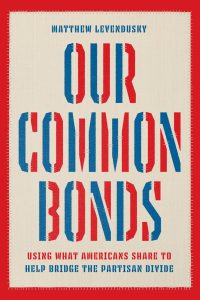Five Questions with Matthew Levendusky, author of “Our Common Bonds: Using What Americans Share to Help Bridge the Partisan Divide”
With the next presidential election looming on the horizon, many of us are wondering how the cultural and political landscape will change leading up to November 2024. Most citizens, however, share the same anxiety: that the acidic political division between the left and right will only worsen in the ensuing months. Author Matthew Levendusky’s new book, Our Common Bonds: Using What Americans Share to Help Bridge the Partisan Divide, explores how conservatives and liberals can again find common ground for the betterment of society. Here Levendusky chats about his inspirations, the surprises he encountered while writing his book, and what comes next.
How did you wind up in your field, and what do you love about it?
I’d always been interested in politics growing up, but I went to college thinking I’d major in philosophy (and then, I guess, go to law school, but that future was always more inchoate). My second semester in college, I took a political science class where we conducted empirical research and I was hooked. That professor connected me with someone who was looking for a research assistant, and I never looked back.
I love the joy of solving a puzzle when you get data that gives you a new insight into the world and allows you to see it a little bit better, and a little bit more clearly than you did before. Getting to show students how to do that is one of the best parts of the job.
While you were working on this project, what did you learn that surprised you the most?
I think the biggest “aha” moment for me was the importance of really listening in conversations. When I conducted the cross-party discussion experiments, I was always struck by the number of people who told me afterward how much they’d learned from listening to someone with a different perspective. Even if they disagreed—and subjects often did—they could see that the other person was more reasonable than they would have imagined based on their preconceived notions of the other party.
Understanding comes before persuasion. Many people think that they can just persuade someone else to change their mind, but that’s rarely true. By genuinely understanding their perspective, you can better appreciate why they hold the views they do, which is the first step to potentially persuading them.
What do you most hope readers will take away from your book?
I hope they’ll learn that it is possible to mitigate the level of animosity in our nation’s politics (though we can only mitigate it, rather than eliminate it). Part of why Democrats and Republicans dislike one another is that they hold very distorted views of one another. When we reduce those misperceptions—by emphasizing our common bonds—then animus falls.
Of course, some level of partisan animosity is a good thing: it highlights the important policy differences at stake in our democracy. There are, of course, some divides that cannot—and should not—be bridged; no one is advocating accepting those who espouse white supremacy, homophobia, and so forth. But those important caveats aside, there are ways of working together to make our democracy stronger.
In The Nation that Never Was, Kermit Roosevelt says that “what makes us American—our deepest ideal—is that we keep trying. . . . The true America is not handed down from the past but created anew by each generation, created a little better, and what we can give the future is the opportunity to get just a little closer than we did ourselves.” I love that idea: the core of Americanness is to try and better embody our deepest values. It also highlights how each and every one of us has agency to help make this nation a better place.
Where will your research and writing take you next?
I hope to continue working with “bridging” groups—the non-profits that bring together ordinary Democrats and Republicans in the quest to find common ground. The goal of that work is to learn how to help them do that more effectively.
Along with several co-authors, I’m also in the process of finishing my sixth book, which explores when partisan animosity does, and does not, have political consequences. We are just about to send the final version of that manuscript back to the University of Chicago Press, so hopefully, readers will be able to read it in 2024.
Beyond that, I’m hoping to start a set of new projects that will explore different topics in polarization, looking at the role of campaign finance, especially small-dollar donors, in polarization, as well as the growth of educational polarization. I keep thinking that someday I’ll work on topics beyond polarization, but every time I finish one project on it, some new dimension of it arises to be studied!
What’s the best book you’ve read lately?
Too many scholarly ones to name! Instead, I’ll suggest a fun one. I spent last year as a visiting fellow at the European University Institute in Florence, Italy, which was an amazing experience. To help me continue working on my Italian back in the US, I’ve been reading (very slowly) Italian detective novels, especially those from the Commissioner Montalbano series by Andrea Camilleri and the Commissioner Bordelli series by Marco Vichi.

Matthew Levendusky is professor of political science at the University of Pennsylvania, where he also holds the Stephen and Mary Baran Chair in the Institutions of Democracy at the Annenberg Public Policy Center. His books include The Partisan Sort and How Partisan Media Polarize America. He is also the coauthor of We Need to Talk (with Dominik Stecula) and Democracy Amid Crises (Annenberg IOD Collaborative).
Our Common Bonds is available now from our website or your favorite bookseller.
